Intro
Throughout the last several hundred years, growth in the farming and agriculture business exploded. After that, during the nineteenth and mid twentieth centuries, the intensive methods we use nowadays were developed. It all culminated into a method that was more intensive than ever seen before. Before, only a portion of all farms used these methods, nowadays, ninety nine percent do. The amount of suffering inflicted is horrendous and alarming. Every conceivable consideration that could be taken for the animals is utterly disregarded. Due to growing awareness of what happens on the majority of modern farms, these methods have been given a new name: Factory Farming. Large groups of animals are crammed together, used to create products as fast as possible. They are kept in horrible conditions and are treated like tiny cogs in a machine. Different animals are mistreated in different ways. But there are common factors. Hundreds of thousands of animals being crammed in tiny spaces too small to stretch or move, diseased animals sleeping in ammonia and feces, cutting off body parts without painkiller, castration without painkillers. Animals that normally live twenty years are killed when they are only a few years old. Some animals are killed months, weeks, days, or even minutes after birth. Other common issues include the overproduction of milk and eggs, separation from parents, and crazed bored animals resorting to cannibalism.
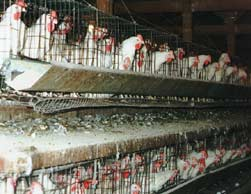
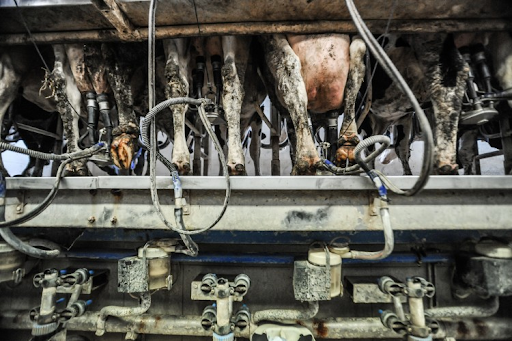
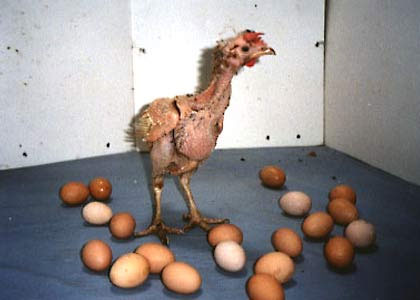
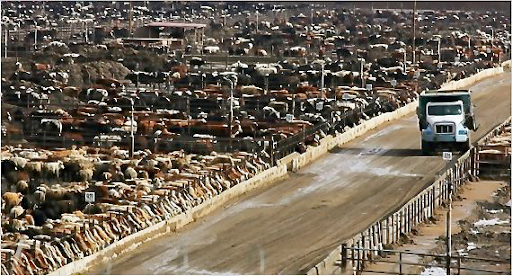
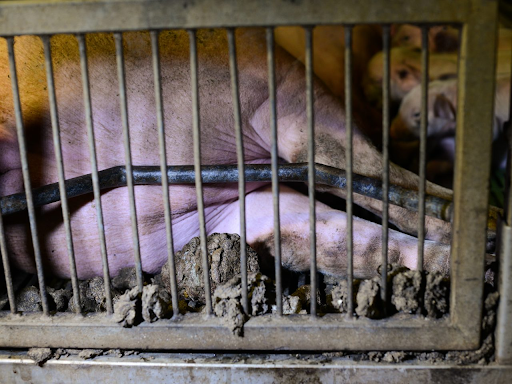
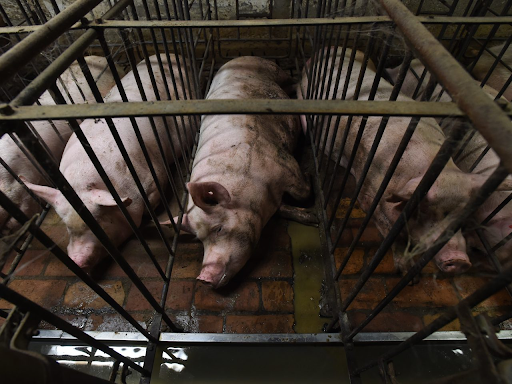
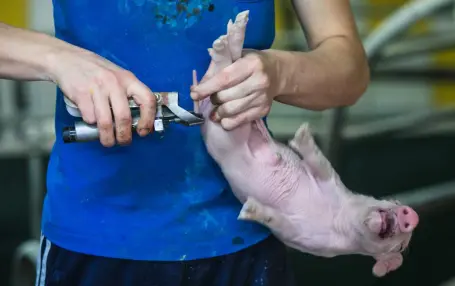
Even traditional forms of farming have involved the suffering of animals. It is inevitable when animals are sold and killed to create a product. Especially if business is growing and the animals need to be managed. But the methods used nowadays are far past the point of anything acceptable. Any person today will be able to see that.
These methods exist to keep up consumer demand, and the growing population of eight billion people. Two hundred years ago, the population was only a billion people, and it had taken all of human history to reach this point. One hundred years later, our population exploded to its current number of 7.5 billion.
People who want to use humane methods must consider that their competitors will not. Those loaned spaces to raise chickens must deal with exploitative business practices. It will be difficult – but large reforms are possible. Small, token reforms such as a couple extra inches of space will not do. These will merely kill momentum, and go ignored. Even these ‘large reforms,’ or as I call them, basic emergency measures, are still band-aids, and we will need more sustainable long term solutions.
But there are important steps you can take as an individual. But first you must be aware that there’s a problem.
This is more of an informational article, and is longer than usual. There are so many things to talk about when it comes to Factory Farms. In a different article, I talk about the impact on human workers and the environment. But first, I need to go over what happens to the animals.
A Quick Word on Working Conditions
I will go into the negative effects of factory farming for humans in a different article. Yet I need to talk about the working conditions on factory farms for a second to describe why these places create such intense suffering for animals. People who participate in cruel practices to animals are often not evil antisocial individuals, but conditioned to ignore the suffering. Take scientists who do cruel experiments. Their teachers did it, they had to do it to stay in school. They had to participate in these studies to keep their jobs. The experiments are often bizarre, wasteful, unpublished, and show things which are already obvious. But it becomes a procedure, or a mere number. A society which already ignores obvious animal issues and uses animals quite freely helps to further desensitize a scientist, who passes the practice down to their pupils. Those who voice concerns are laughed at for being irrational, and too sentimental. Similarly, people take jobs at meatpacking plants and factory farms out of desperation. The workers are treated with utter disregard for their wellbeing. Factory Farms are so horrible that this field of work has one of the highest turnover rates out of any other industry. Most people can only endure so much and quit within a relatively short amount of time. The area is filled with ammonia, a gas which forms when large quantities of feces and urine are allowed to sit for a long time. It burns people’s lungs and eyes, so workers have to wear special masks. People who work there have noted that they get to go home at the end of their shift, while the animals don’t. The average worker has to butcher an average of 250 cows an hour. There are so many animals crammed in spaces too tiny to move. Practices like killing newborn chicks as soon as they’re born, cutting and castrating without painkillers, and other atrocities make the job unbearably stressful. Animals are often slaughtered improperly, causing excruciating pain. So people quit. Sometimes up to a hundred percent of the workforce each year. But this makes the problem worse because this causes workers to be new and inexperienced. Because workers are inexperienced, animals are slaughtered improperly, and conditions further deteriorate.
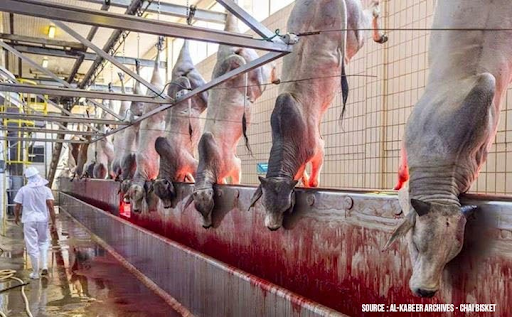
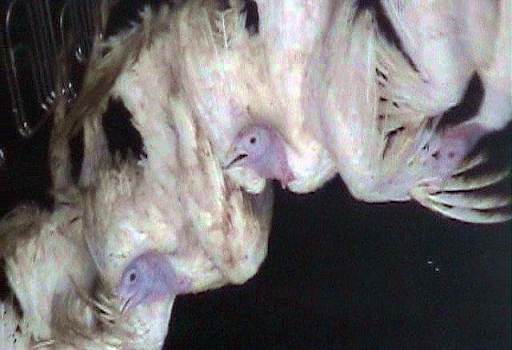
Chickens
The discovery of vitamin D allowed farmers to keep chickens confined all year round. Before, it was difficult to raise chickens during winter. Egg production, meat production and incubation were more difficult. In the thirties and early fifties, 1500 hens could provide a full time job for a farm family in America. Egg prices started to fall dramatically, so farmers started to triple the amount of hens they had, keeping three chickens in cages originally meant for one. Things got worse. By the late fifties, large farms and packing plants could grow birds by the tens of thousands. On average, a chicken only lays one egg a day, but not every day of the year. In 1900, the average egg production was 83 eggs per year. By 2000, it was over 300. Chickens also grow to market weight in six to seven weeks. Fifty years ago, it took three times as long. This is because of genetic selection and nutritional modifications. Not growth hormones. These are illegal for chickens in the U.S and other countries. Not to mention that growth hormones wouldn’t work. The reason growth hormones aren’t used is probably not for the sake of the animal’s wellbeing, but to prevent danger to humans. However there are a huge number of other risks posed to humans from other practices done to chickens.
Newborn chickens are placed on a conveyor belt where workers check if they’re male or female. There are large amounts of chickens on the belt as soon as they’re born. Newborn males are gathered up in trash bags and killed immediately, since farms don’t need them. The chickens are either suffocated, decapitated, gassed, crushed or ground alive. Baby chicks often fall into part of the machine. They are trapped, then they die. There are so many chickens being passed down the conveyor belt, that no one tries to prevent this.
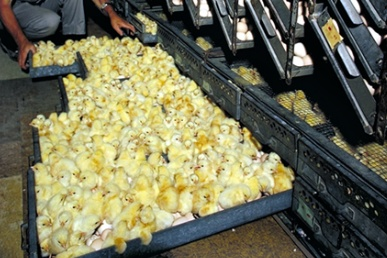
The female chicks are picked up and have their beaks cut off with a hot iron. No painkiller is used. The process is not only painful when it’s being done, but hurts for a long time afterwards, because the beak is filled with sensitive nerves. Debeaking involves slicing bone, cartilage, and soft tissue.
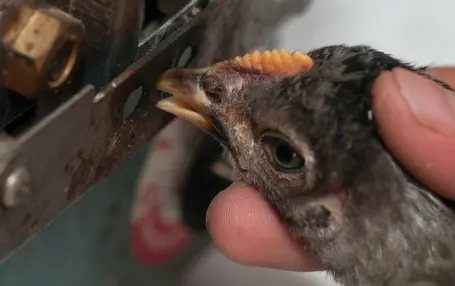
Five to eight birds are crammed into 14 inch cages each. The space is so small that birds can’t even stretch their wings. Minimal reforms are passed outside of America, but nothing significant. The conditions are still horrible, and the only countries which have passed meaningful legislation would be countries such as Sweden, Norway, and Switzerland. Often the typical regulations added in most countries are, less birds in a cage, or a few extra inches of space. These are often not enforced, and when whistleblowers check, they find that regulations are ignored.
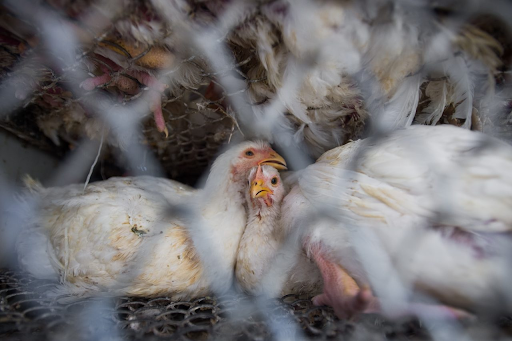
Chickens naturally form a social order if left alone. Due to all the chickens being crammed together this is disrupted. This, combined with stress and most likely sensory deprivation, causes the birds to become aggressive. Debeaking is done to prevent the birds from pecking each other, because a corpse covered in peck marks is less profitable. Similar to other animals on factory farms, stressed chickens resort to cannibalism.
Cage floors slope to the bottom, and the cages are made of uncomfortable wire, which chafes skin, bruises, rips out feathers, and deforms their feet. Weaker hens are often crushed at the base of the cage. One in five die of stress and disease. Others are turned into animal feed.
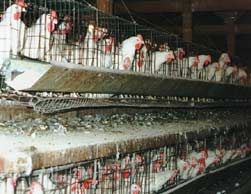
Manipulation of light is used to increase egg size and production. Thus the chickens lay more eggs, at times their bodies wouldn’t naturally. At the end of their laying cycle, they are either killed or subjected to a process known as forced molting. Chickens are kept in darkness and not given food and water for eighteen days. This shocks the body into a new laying cycle. Many die from fatigue.
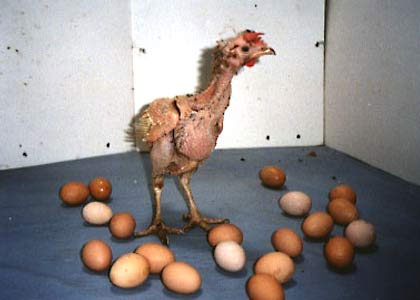
Broiler chickens are bred to be so heavy, their bones can’t support their weight, they have difficulty standing, and their legs often break. They’re raised in overcrowded areas and become aggressive, so their beaks and toes are cut off with no painkillers.
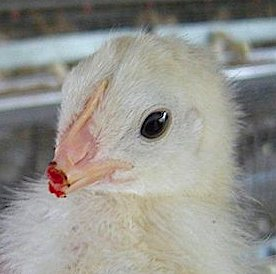
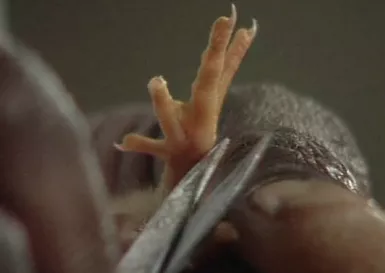
Chickens breathe in ammonia every day. Because of this, and the other horrible conditions they are subject to bacterial infections, lung problems, broken bones, and crippled legs, among a large host of other problems.
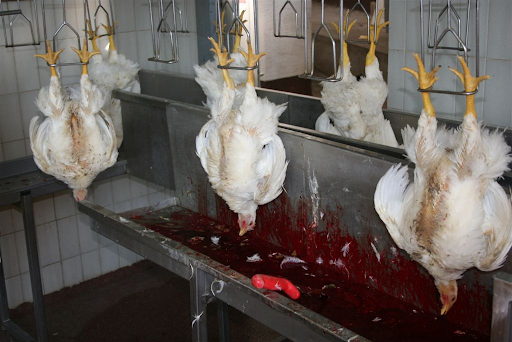
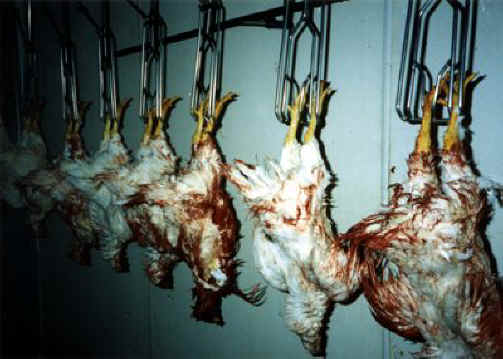
Turkeys
Turkey’s are treated pretty similarly to chickens, and what turkey’s go through on farms isn’t covered much. Not even on Wikipedia. However, I will try to go into more detail. Similar to chickens, their toes and beaks are cut off without painkillers. This is to prevent pecking marks on the corpse. In chickens they remove these body parts, because chickens get so stressed that they become aggressive. Similar to chickens, turkeys are crammed into tiny areas too small to move, up to 15,000 can be crammed into a single factory building. Turkey’s are given less than three feet of space. While this is more space than given to chickens, turkey’s are bred to be larger. Both are bred to be so large that their bones can’t support their weight, and their legs break. With turkey’s the problem is more severe. Farmers are paid to breed turkeys with enlarged breasts. But the animals become so heavy that they can’t reproduce naturally. Thus artificial insemination is used. This practice is common in any animal industry, and the methods used here are heinous. Workers extract semen from males by hand simulation and massage. To inseminate a hen, workers have to apply enough pressure to the abdomen so that the cloaca will open, and then they insert a syringe into the vagina.
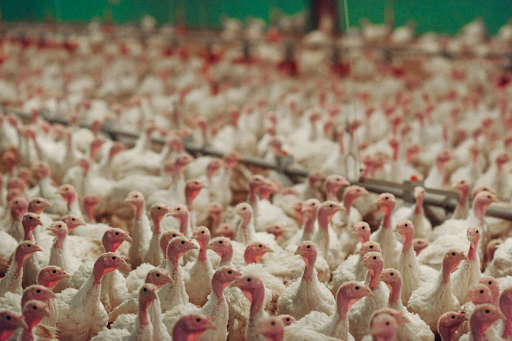
But this is not all. Here I will give the first example in this discussion about how animals are slaughtered improperly. The Humane Methods of Slaughter Act requires animals to be unconscious before slaughter, but this law doesn’t apply to birds killed for food.
They’re put in an electric bath which stops them from moving, but doesn’t knock them out, because that would make the bodies less expensive. An automated blade then slits the animals throats, but since there are so many birds being killed very quickly, the blade often misses, so a human worker will have to come and finish the job. Workers typically have to handle hundreds of animals every hour. Because of high turnover rates, new workers are often inexperienced. Even when human workers go in and check whether every animal has been killed, they still miss a lot of them. After the turkeys are supposed to have been killed, their bodies are put in tanks of scalding hot water. Those who aren’t killed are boiled alive. These turkeys are nicknamed “redskins.”
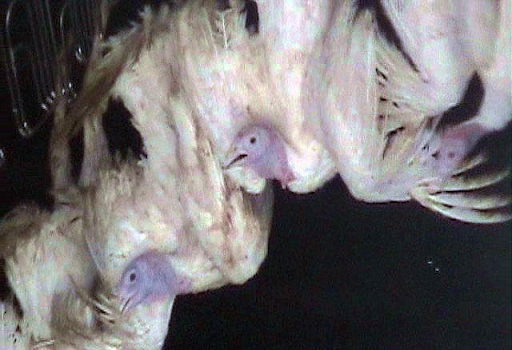
Cows
There are three types of cows in the animal industry. Dairy, Beef, and Veal Cows. All three are intertwined based on what is most profitable for the animal industry. Many people nowadays would agree that killing a several week old or month old baby cow to create the so-called delicacy known as veal is cruel and barbaric. Many people vaguely know about the crates the baby cows are kept in, or the fact that we try to keep their flesh pale and tender. But the veal industry is directly connected to the dairy industry. Making calves into veal is merely a method to maximize profit.
Male cows are typically not as profitable to raise. A female cow can produce babies, milk, and eventually be made into dog food or hamburger meat. A male cow can only be made into veal, or raised for beef. If we passed legislation to outlaw veal production, the industry could still make plenty of profit by simply raising their male cows to be made into beef. Yet losing the ability to make a quick buck by turning a baby cow into veal would haunt them, and they would try to make the money back with some other unsavory method.
This is similar to how when we make reforms for people, companies make unnecessary cutbacks to avoid short term losses, like not making more money in February of this year, compared to February of last year. The factory farming industry might try to make its money back by using some loophole, or breaking one of our many animal welfare laws which either doesn’t get enforced or is too vague. This doesn’t mean we should be apathetic and content to do nothing. The meat packing, slaughtering, and animal agriculture industries are corrupt and need to be fought at every turn. This is necessary for anyone who even slightly cares about the overall good of our society. They abuse their workers and animals. The diseases, pollution, hormones and antibiotics that come from the meat industry are bad for humans all around. Cows are put in filthy conditions which breed disease to maximize profit. Afterwards farmers use antibiotics, even when they’re not needed. I will go into the conditions of the veal industry in this article, but discussing it further will require its own separate blog post.
Dairy Cows
Most dairy cows are reared indoors, either in crowded areas, or in small pens with only enough room to stand or lie down. The environment is completely controlled, with artificial lights, temperature and feed, calculated to maximize milk output. Sixteen hours of light, eight hours of dark. Cows are forced to produce ten times more milk than their bodies are supposed to produce naturally. They are hooked up to a milking machine. The machines cause injuries and give electric shocks to their udders. Overmilking leads to infections, which make the milk unsanitary.
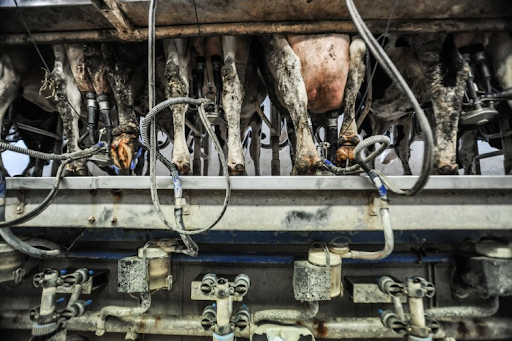
Cows have to be impregnated in order to make milk. This is done via artificial insemination. Once the cow gives birth; her calf is taken away. This obviously causes sadness as you can hear both animals bellowing when the separation happens.
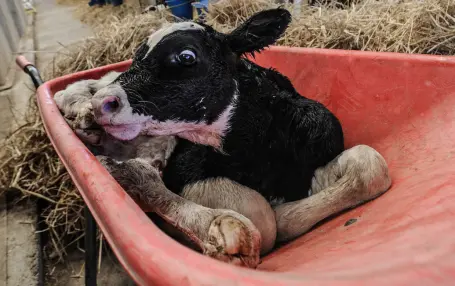
The cow is milked twice or sometimes three times a day for ten months. After three months she is made pregnant again, and is milked constantly until about six to eight weeks before birth. Afterwards the animal is impregnated. Cows are made perpetually pregnant. The overmilking and perpetual pregnancy can only last about three to five years, before the cow’s body gives out. She is then slaughtered to be made into hamburger or dog food.
In order to maximize milk production, cows are fed high energy foods like soybeans, fish meal, brewing by-products, and poultry manure. But their bodies are not meant to digest this. Cows are meant to digest grass. The cow produces milk faster than she can digest her food. Thus, her body ends up consuming its own muscle, causing her to start ‘milking off her own back.’
Bovine growth hormone is used to maximize milk production for cows. Not only are the cows sore from daily injections, but the use of these hormones forces her body to work harder, further deteriorating her muscles, and accelerating exhaustion.
Artificial insemination used to be considered a new and unusual method. Now it is common practice. Additional practices are in development. In the sixties the first calves were produced using embryos transferred from one cow to another. A hormone is used which allows a cow to produce more egg cells. After being artificially inseminated by a prize bull, the embryo can be removed from the womb, and transferred to a cheaper surrogate by making incisions in their flanks. In the seventies we gained the ability to freeze embryos, and now, 150,000 embryo transplants are attempted each year. Perhaps genetic engineering and cloning will be the next step in turning living breathing animals into machines.
Beef Cows
Compared to other animals such as pigs and chickens, beef cows get to see the most time outside. They used to be able to roam and eat grass for two years before being moved to a feedlot. Now it is standard to only wait for six months.
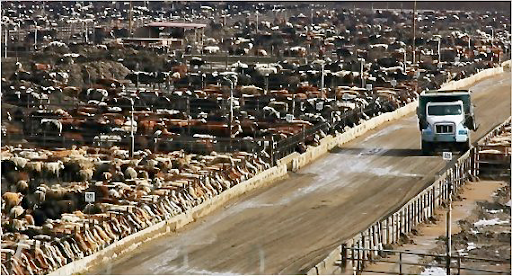
It’s common practice to cut out pieces of their flesh, cut off pieces of their ears, or to brand them so that the farmers have an easier time identifying their property. Though a cow’s hide is thicker than a human’s skin, the brand is held onto the cows hide for several seconds, which burns their flesh and causes them pain. All of this is done without pain killers. It is also common practice to cut off pieces of a cow’s horns. This is also done for identification purposes and due to the sensitive nerve endings, this causes pain.

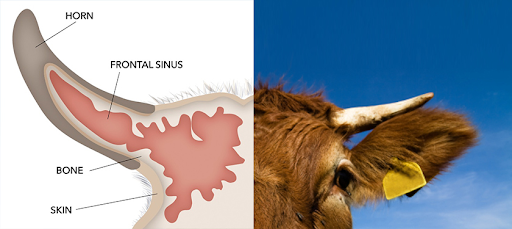
The animals are also castrated. Methods of castration involve cutting open the scrotum and tearing the chord in between the testicles, or tying a cow’s scrotum with a band and waiting several weeks for the testicles to fall off. All of these things are also done with no pain killer.
They live in cramped, dusty holding pens, filled with their own feces and urine, which creates the gas known as ammonia. Their movement isn’t as heavily restricted, but the areas are still cramped, and the cows experience stress and boredom from the unchanging environment. Calves separated from their mothers are either made into veal or become beef and dairy cows. The males become veal or beef cows, the females become dairy cows. Calves made into beef or dairy don’t get to drink any milk, as the milk is taken to be used by humans. They’re fed a liquid substitute instead. This substitute is often lacking in nutrients so the cows become unhealthy.
Cows are often slaughtered improperly, and the process is painful. They are supposed to be knocked unconscious before being killed. Many workers, up to a hundred percent, quit their jobs every year at slaughterhouses and factory farms. Workers are new and inexperienced. In addition, workers are in a rush to stay on schedule, and have to slaughter an average of 250 cows per hour. Workers often don’t stun the animals properly, and cows struggle while being hung upside down. Their throats are cut. It is also a large possibility that even when animals are stunned properly before being slaughtered, they still feel pain and just can’t move.
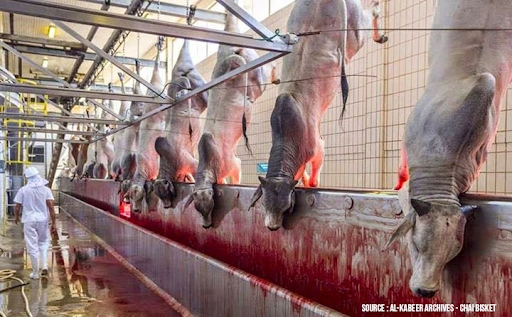
Veal
Veal calves live in small wooden crates. Some are chained. They can’t even turn around or stretch their legs. The floors of their stalls are slatted, which causes joint and leg pain. They never get to see the sun, touch the earth or eat grass. They often become too sick and crippled to walk. Ten percent die from confinement. These cows are either killed only a few days after being born, or after they are sixteen weeks old. The ones killed after only a few days are made into low grade veal for frozen dinners. This shows that veal isn’t actually some sort of delicacy, or a symbol of status. It’s just a cheap way for the farm industry to save a little extra money. We often use euphemisms to help us forget where our meat came from, like beef instead of cow, or pork instead of pig. With this type of meat, what we do is especially heinous. We use bougie words like ‘veal’ as a euphemism, instead of just calling it what it is – ‘tortured baby cow.’ We purposefully don’t allow veal calves to move so that their flesh will be soft. Veal calves separated from their mother are given a liquid milk substitute. They are purposefully not fed any iron so that their meat becomes more ‘tender and pale.’ This doesn’t actually make the meat taste any better once it’s cooked. This is just done so that the people who eat it can feel more fancy. They’re often not given any water either. The calves crave iron so much that they lick the metal bars of their stalls, even if they are covered in their own urine.
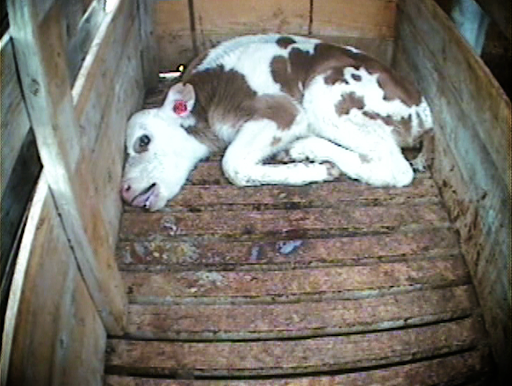
Pigs
Pigs are extremely social and intelligent animals. In a natural setting they will form small groups with mothers and children. They can learn tricks, and be taught to play simple video games where they control the joystick with their snouts. When the smaller varieties live with people, they are very friendly and loving towards their human companions. The intelligence of different animals is impossible to quantify and objectively compare. Different animals process things differently, and there are many different categories of intelligence. Yet in the areas I described pigs show even more intelligence than dogs.
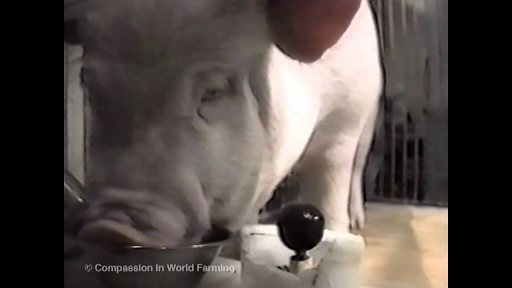
Yet we do things to them, which we would never want to see done to a dog. We still have industries in America that do similar things to dogs that I’m about to describe being done to pigs.
Pigs are very sensitive to heat and can’t sweat, so their environments have to be carefully controlled for temperature, either through ventilation or by dripping water into their environment. Pigs naturally want soil under their feet, and are more comfortable when they have straw to lie on. They receive neither. Pigs are supposed to cool off by rolling in the mud. They are given a hard floor to lie down on instead.
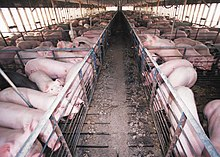
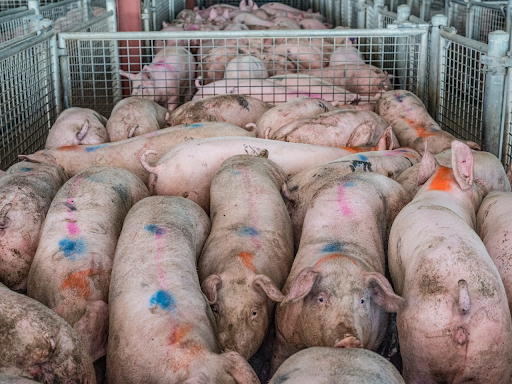
Female pigs are kept perpetually pregnant. They naturally are supposed to spend 13-17 weeks nursing their young. As soon as they give birth they are given two to three weeks, then, immediately impregnated again. Fifteen percent of their babies will die before they are sent away to be fattened up for food. As usual, it isn’t profitable to keep the male animals around, so artificial insemination is used. The female, on account of her sex is viewed by the industry as a baby creation machine. The sows kept perpetually pregnant are moved to a sow stall, or gestation crate. They are pregnant, forced to lay on the hard floor, and their legs are crippled as a result. They have no room to move around.
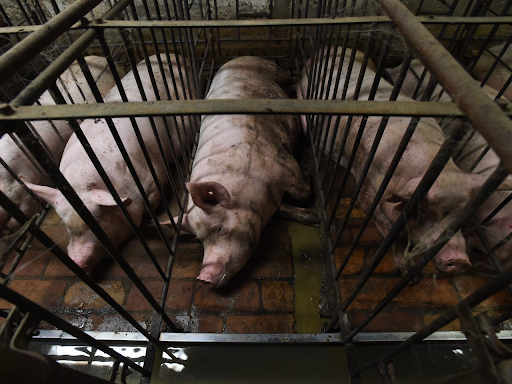
Each time a female pig is re-impregnated, she is tied to a crude metal device known to the industry as a ‘rape rack.’ For the animal the experience is painful and terrifying. Cows are impregnated until their bodies can’t take it anymore. After that they’re killed. For pigs it’s different. Each time a pig is impregnated, she becomes less fertile. Once the pig isn’t fertile enough anymore – then she’s taken away and killed.
These stalls save the industry a lot of money, but have raised a lot of alarms for animal welfare. The conditions of these stalls are so horrible that they have been outlawed in the American states of Florida and Arizona. Unusual for a country that lacks even the most basic animal welfare laws compared to the rest of the world. On the other hand, the welfare laws that the rest of the world has are pitiful, and nothing to brag about. Sow stalls have been outlawed in the UK – a country renowned for its better treatment of animals. Large companies, perhaps to salvage their image, have talked of plans to quit using these stalls, although investigations of the buildings show that they have no intention to do this, and that the stalls are widely used. It’s not like they have an incentive to get rid of the stalls.
In the stalls, the female pigs can’t move or turn around. They are sometimes chained. The floor is slanted downwards, which causes injuries. Out of frustration and boredom, the pigs neurotically bite on the bars of their cages, which causes tooth injuries and mouth sores.
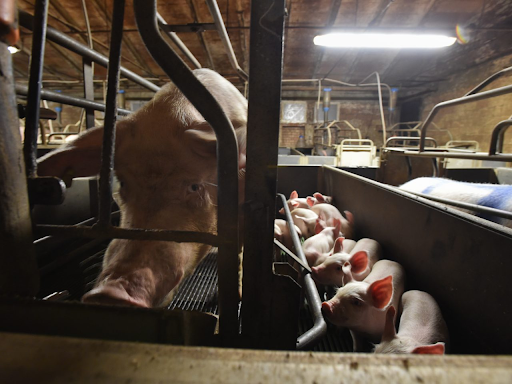
Unlike other animals forced to sleep in their own urine and feces, the industry attempts to pump some of the excrement out of their cages. This is because pigs produce so much of it, about thirteen pounds a day, 4000 pounds a year. We breed millions of these animals every year to satisfy human demand, and when they release feces, they are pumped away.
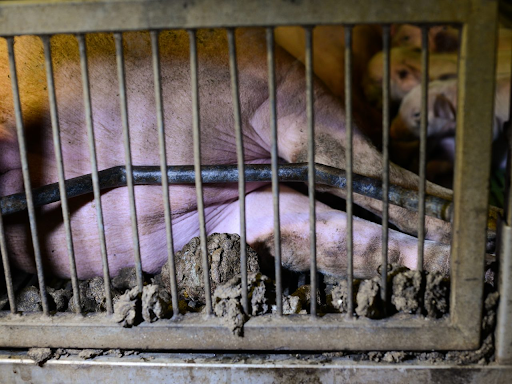
This waste comes in contact with workers, local residents, and contaminates our water. The pigs still sleep in their own feces, don’t get me wrong. It causes ammonia to build up, and the gas burns the lungs and eyes of both the workers and animals. It eventually is pumped out of the cage, but a lot has to build up first.
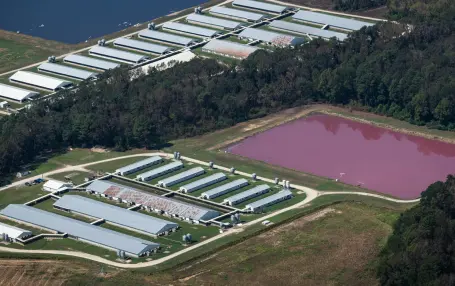
As Per Usual the pigs are fed a special grain meal, combined with soybeans. Low quality meat and bone-meal is added. Due to filthy conditions and close proximity to one another, the animals have a lot of diseases. These diseases have the potential to spread quickly. The types of diseases bred on these farms obviously affect the animals, but also are at high risk for causing an outbreak among humans. To control the spread, antibiotics are added to the pigs’ food, which make their way into human customers.
After the piglets are separated from their mothers, they are sent to live in overcrowded pens. The floors are made of wire mesh, metal, or fiberglass. The conditions cause the animals to experience so much stress, that pigs start to become aggressive. They will bite each other’s tails, and if the animal tastes blood, this causes them to go into a frenzy. Both the mothers and piglets sometimes resort to cannibalism. None of this behavior is natural and is extremely abnormal for such friendly and social animals. This is like if a group of humans living in a prison went insane and started eating each other.
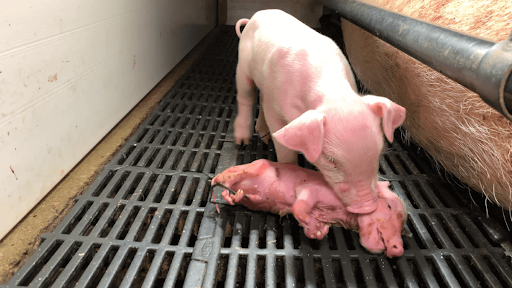
These animals have their tails cut off, and pieces of their teeth chipped away to prevent tail biting, not out of concern for the animals, but because a corpse with bite marks is less profitable. Notches of the ears are removed so the owners can identify their property. The animals are castrated. All of this is done without painkillers. The methods either involve cutting open the scrotum and tearing the cord in between the testicles, or tying a rubber band around the scrotum and waiting several weeks for the testicles to fall off. Again, this is done without painkillers. There is no incentive to use any.
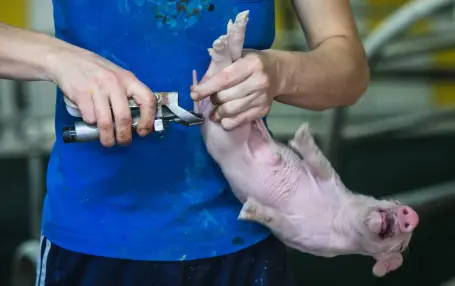
Very few males are kept around because they’re not profitable, but the ones kept are castrated early to prevent male hormones from tainting the meat. The animals are sent away to be slaughtered when they’re only six months old. Pigs naturally live to be ten or twenty.
A lot of people at these jobs quit, so workers are new and inexperienced. Many animals have to be butchered quickly, so they’re often slaughtered improperly. The animals are supposed to be stunned before they’re killed, but are often not. It’s possible that even when the animals are stunned, they feel pain but just can’t move. The animals struggle while being hung upside down. Their throats are cut. The ones whom the blades miss are dunked in a scalding tank and boiled alive.
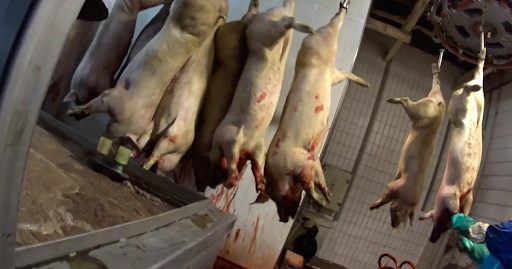
Sheep and Goats
Very little is written about goats for factory farming. So I’ve put them in the same section as sheep. What these two types of animals have in common is that they’re exploited on three fronts, their meat, milk, and hair. People think that producing wool is just a haircut for the animal. This isn’t true. I’ve will talk about this topic specifically in another article. It is an industry, which is fueled by a product which comes from an animal’s body. This inevitably leads to exploitation. The animals are treated badly in order for the industry to be efficient and keep up with consumer demand.
Sheep have it especially bad because they’ve been selectively bred to produce more wool. A sheep left out in the wild for a couple years will grow hundreds of pounds of hair, and will risk dying of heat stroke. They didn’t start out this way naturally. If they had, their ancestors would have died out long before we could have captured and domesticated them. So if we do take care of sheep without using their hair we should give them haircuts but not turn them into an industry to produce our clothes. Sheep are kept in smaller numbers compared to other animals, but the conditions are still cramped and filthy. The average building has about 1000 sheep crammed together. The top 0.1 percent of farms have twenty percent of the United States sheep, and keep flocks of 100,000 crammed together.
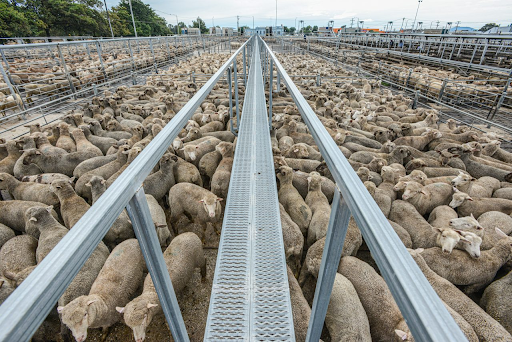
Because the conditions are so filthy, their fur becomes matted with dirt and flies, growing mold and fungus. Sheep become susceptible to flystrike, a skin infection caused by maggots. To prevent fly strike, areas of a sheep’s backside where maggots like to burrow are sliced off. Pieces of the skin are removed. Painkiller isn’t used, and is merely recommended in Australia, where a quarter of the world’s wool is produced.
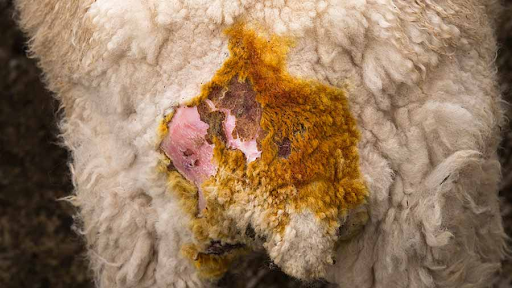
Feces will build up around a sheep’s tail, so the tail is removed. This isn’t done out of love for the sheep. We wouldn’t have to do this, if sheep roamed free and were taken care of, instead of used for wool. The two methods are either slicing it off, or tying a rubber band around the tail until it rots and falls off. This practice increases a sheep’s risk of having their rectum prolapse.
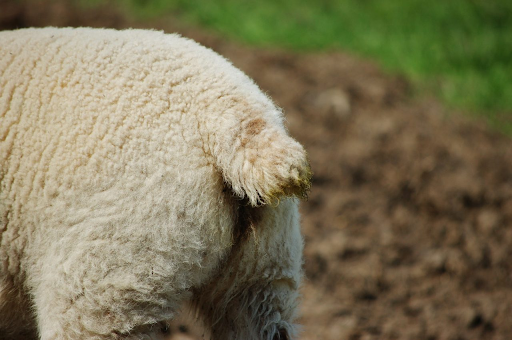
Sheep are often starved before being sheared so that they’re too dizzy to react to stress. Shearing is a low wage high risk job. Workers have to shave as many animals as possible each hour quickly.
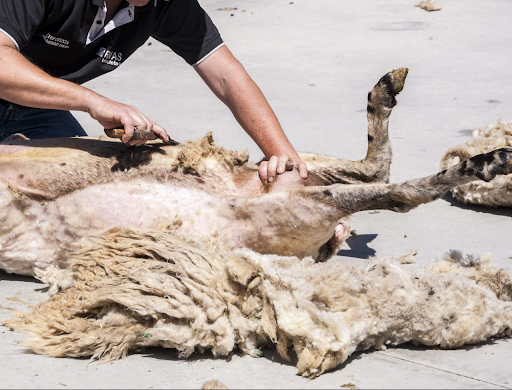
Terrified animals like goats, llamas, and sheep are pinned down. The workers often cut the animals, but also accidentally injure themselves. The risk of injury is higher here than any other field. This is terrifying for the sheep because these are prey animals.
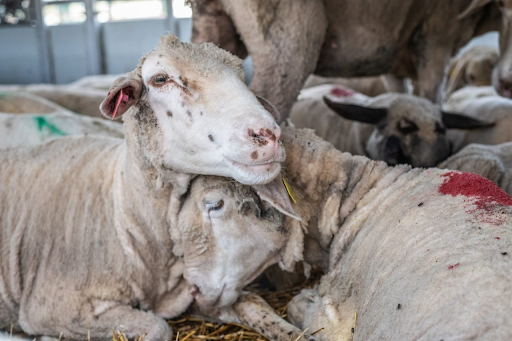
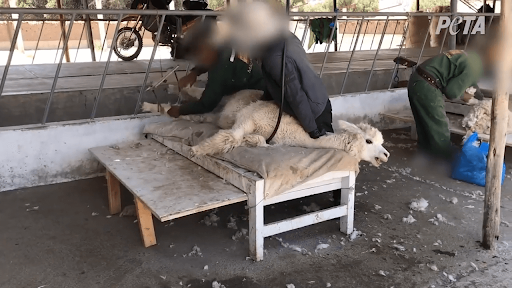
Goats grow less hair and are only shaved twice a year, but the process is still painful and produces fear. Goat hair is called cashmere, and most cashmere is produced in the cold mountains of China and Mongolia. Herds of goats are kept, and are often shaved in the winter to meet consumer demand, causing many of the animals to freeze to death.
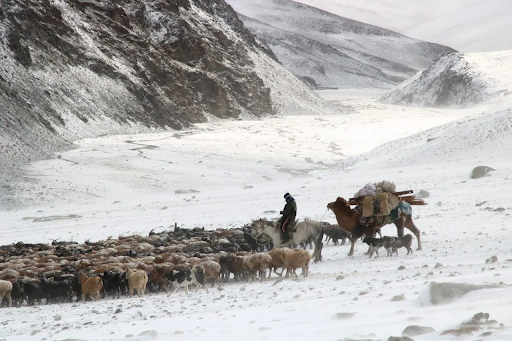
Sheep produce less wool when they’re older, and when they’re too old to make enough money, they’re sent away to be killed for meat. Sheep meat becomes mutton if the animal is about a year old. Sheep naturally live ten to twelve years.
We rightly see the veal industry as excessively cruel and barbaric. Baby cows are kept confined in crates, and purposefully not fed iron to make the meat more white, so that the people who eat it feel more fancy. This doesn’t make it taste any better once cooked. Like the consumption of any baby animal; it’s presented as a status symbol; when it’s just a way for the industry to save money on male animals; which are less efficient for profit. Baby cows killed only after a few days after being born are made into low grade frozen dinners. With baby cows, we use bougie words like ‘veal’ to cover up what it really is. When baby goats are made into meat, we call it ‘Cabrito meat.’ They’re killed only a week after birth.
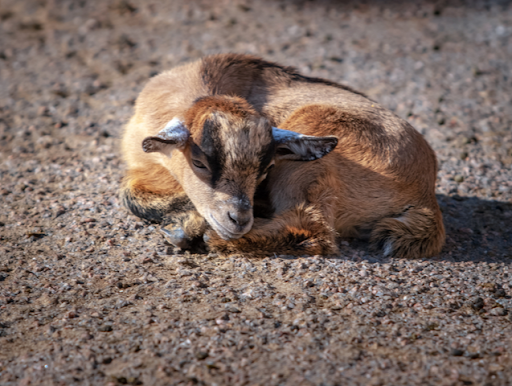
With lamb, we don’t even bother with a euphemism, because we associate lambs with ritual sacrifice. In fact, in The U.S, people prefer lamb meat, perhaps because of religious imagery, or the idea that the meat of a baby animal is softer and that lamb meat is less flavorful than mutton? Rather than softening mutton up in meat tenderizer, we eat lamb, because the word lamb brings up nice images in our mind, rather than the horrific slaughter of a baby animal.
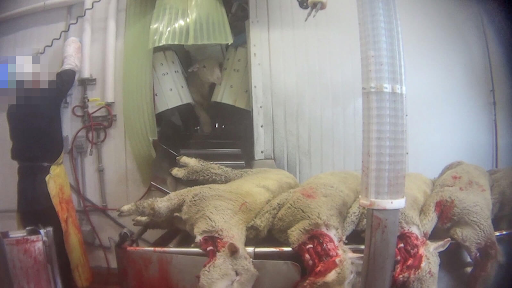
Sheep are in particularly high demand when it comes to meat slaughtered in accordance with religious tenets, although these rules apply to other animals. The government has laws requiring that animals be stunned before being killed. However, exemptions are provided for religious requirements. These rules forbid the use of animals which are sick or injured, and require that they be killed with one fell swoop of the knife. Therefore, an animal can’t be knocked out before being killed. Back when these religious laws were written, this was probably the best method available. However, religious rules, combined with our sanitary laws which don’t allow one animal to lay down in the blood of another animal have created a horrible combination. Instead of quickly slamming the animal to the ground and killing it, we hang an animal like a cow upside down. There are a lot of animals to kill, and the guy who cuts the animal with one swoop has to make sure not to miss. All the while the panicked animal is resisting. While hung upside down its leg bones crack and the skin slides off. One book I read said the following quote, “It’s harder to imagine a better example of how strictly sticking with the letter of a law can pervert its spirit.” Due to changing times, even some orthodox Jewish rabbis and groups of Muslims no longer believe this is the correct way to carry out their religious tenets. Parts of the animal which are forbidden are separated and sold on the open market with no label indicating its origin.
Goats have to be impregnated every year to keep producing milk. Through artificial insemination, they are kept perpetually pregnant. The males are considered less efficient. There are a lot of them, which are unwanted. They are castrated and quickly slaughtered for meat. The castration method either involves cutting the scrotum and tearing the cord between the testicles, or tying a rubber band around the scrotum and waiting several weeks for the testicles to fall off. No painkillers are used.
The females aren’t fed milk, but instead given formula. These young animals are impregnated as soon as it’s physically possible. They produce 1-3 liters of milk a day, 7000 liters over ten years. A whole bunch of goats are lined up on top of a machine to which their udders are hooked. When the exhausted female animal can’t take it anymore, they are slaughtered for meat.
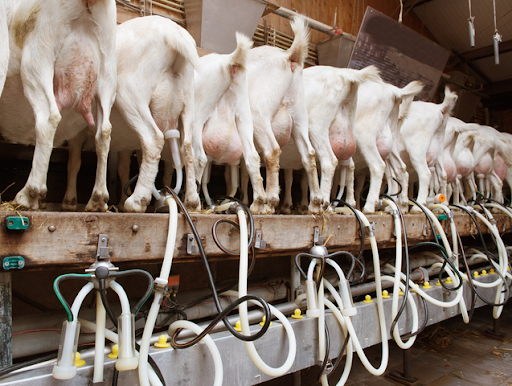
Goats grow horns which fall off for part of the year but then grow back, similar to hair, teeth or fingernails. Goats used for their hair have their horns removed, so that the animal doesn’t resist while shaven. The horns are removed with a hot iron, and the skin is burned to ensure that the horns won’t grow back. It would be like if you had your entire fingernail removed, but a hot iron was used to prevent it from growing back, but the analogy is worse because horns are much larger than fingernails. A more applicable body part would be your teeth, though they are small, they’re on top of your gums, which are sensitive. Imagine a molar which is firmly in place being forcibly pulled out your mouth and no painkiller is used, but imagine that it’s 100 times larger and attached to your skull. Combine that with the pain of putting your hand in the oven with no glove. That’s what they feel. No painkiller is used. Not only does dehorning cause pain and stress during the operation, but also causes pain for a long time afterward.
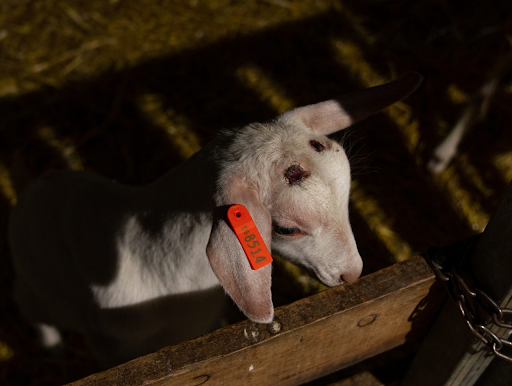
Sheep are crammed into tiny stalls which are only slightly larger than their bodies. While they’re luckier than animals that live their whole lives in cages which are barely the size of their bodies, even this life is unhappy and cramped. The animal still can’t turn around. They’re attached to a milking claw and a vacuum tube which pumps the milk out of her udders. The stress caused by this machine can cause Mastitis, a painful swelling of the udders, which leads to unwanted bacteria in milk. As with other animals, sheep are castrated without painkillers, either by cutting open the scrotum, and tearing the cord between the testicles, or by tying a rubber band around their scrotum, and waiting several weeks for the testicles to fall off.
Fish
Fish are either raised on farms, or caught commercially. Fish farming is as big and developed an industry as beef farming. Both methods have welfare and ecological issues, for both people and animals. Fish farming is unsanitary, inhumane, and poses a risk for humans.
We’ve already succeeded in portraying sheep and chickens as empty headed creatures with no wants or desires, even though these are social animals that form communities and experience pleasure.
So you know fish stand no chance. A lot of what they do isn’t visible, so people consider them barely sentient at best, if they consider them to be conscious at all. But fish do feel pain. Put simply, all vertebrates do. The label of vertebrae means an animal has a brain, nerves, and a spinal cord. Fish and reptiles have important differences in their nervous systems compared to mammals, but they still have the same basic layout of nerve pathways. They’re going to feel something if you cut their bodies open or stick a hook in their mouths.
Besides this, a fish will suffer if they are unable to breathe, or forced to live in a cramped area with filthy water. Fish avoid and react to pain. They have eyes, which they use to see things. These aren’t just cameras on a robot to help them get from place to place. If this were the case, they wouldn’t have spent millions of years developing complex eyes. They would have just developed a simple bundle of nerves that could detect light.
Fish have been shown to be able to solve basic puzzles, the idea that goldfish only remember things for three seconds, or thirty seconds, or whatever made up number you’ve been told is an outright lie. Tests have shown they can remember things for up to three years. Fish make sounds, but the sounds they make aren’t able to be heard with the naked human ear. Researchers have uncovered that fish make different calls to each other, to communicate things like alarm, or aggravation. fish show signs of distress when taken out of the water and allowed to flap around on the ground until they die. The following quote states the next point better than I can; “Surely it is only because fish do not yelp or whimper in a way that we can hear that otherwise decent people can think it a pleasant way of spending an afternoon to sit by the water dangling a hook while previously caught fish die slowly beside them. “
Originally fish farming only included freshwater fish like trout, but eventually people figured out how to raise sea fish. They do this by putting cages in the ocean. Both types raise all sorts of welfare questions which haven’t even been investigated. For example, Salmon have a strong instinct which impels them to return to the place they were born to lay their eggs. Naturally these creatures will make the journey from the ocean back to a fresh river, and swim up waterfalls to do this, while avoiding grizzly bears. Being trapped in a cage in the ocean doesn’t allow them to do this, or much of any exploring at all.
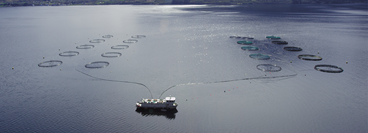
There are also issues of stocking densities, or how many fish are crammed into an area, and the stress fish experience from handling. Stress from handling hasn’t been investigated in detail, but it’s obvious that fish experience physical stress from their handling.
Fish which are farmed are often put into small enclosures where disease and suffocation are common. The areas are filled with their excrement, together with other health risks to humans. In response farmers have to feed them chemicals, herbicides and drugs. These make their way into human consumers.
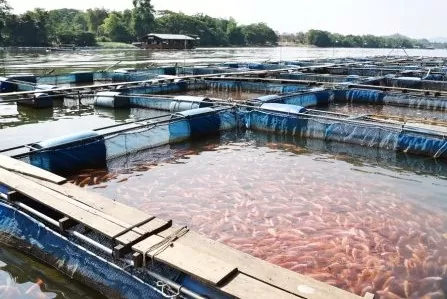
Once the fish reach slaughter weight, they’re poured into large mesh cages. They’re then picked up by trucks to be taken to market. At this point the fish can’t breathe. The trip is stressful for the fish, who are all piled on top of each other in a vibrating car while they suffocate. Even people and small animals can feel the vibrations of car. This must be even worse for a tiny fish. This type of stress is harder to visualize for someone who doesn’t get carsick. Most people don’t pay attention to how much cars vibrate. Many fish die during the process. The ones who don’t die during the trip slowly die from suffocation in the market. If the fish was caught from the deep sea, the change in pressure will cause the fish to die from decompression.
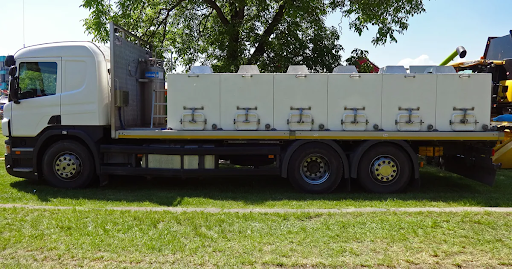
These are just the problems with farmed fishing. Wild fishing doesn’t cause us to waste food like grains and soybeans, it causes other ecological problems. We overfish entire areas, causing the areas to run out of what we consider to be good fish, so we end up catching a lot of what we consider bad fish. Animals which are caught on accident, are considered trash, and trash is dumped overboard back into the ocean. Often, marine mammals like dolphins are caught in the nets. 80,000 marine mammals are caught each year, and are often dead when tossed back into the water. When the animals are trapped, they often can’t breathe and die from drowning.
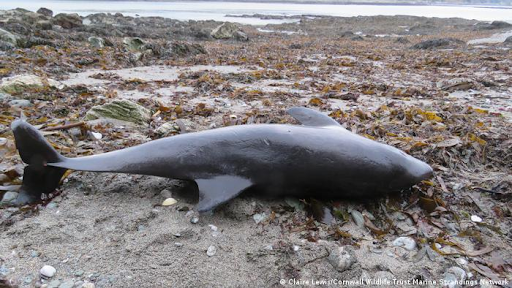
Trawling involves dragging a net across the ocean floor. This area is previously undisturbed, so when we do this we damage the fragile ecosystem of the seabed. This form of fishing is wasteful of fossil fuels, using more energy than is produced. Coastal villages often use fishing as a source of food and money, but because of commercial fishing, their sources of fish are drying up. So the fishing industry of developed nations has become one more way of redistributing wealth away from the poor and to the rich.
Downed Animals and Free Range Farms
Downed animals are animals that are so sick and exhausted that they can’t walk. They collapse on the ground, multiple animals on top of one another, and are allowed to sit there for days, before being dragged away by chains, wenches, forklifts or tractors. These are either poured onto enormous ‘dead-piles’ or sent to the slaughterhouse.
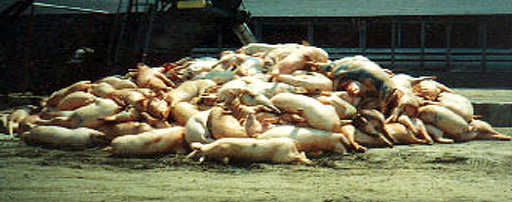
A word on free range farms. The Department of Agriculture helps regulate labels for free range farms, but they rely on the honor system. The farms in question self-report. So a product could be labeled as free range when it actually isn’t. It’s very well known that we have animal welfare laws that are often ignored, or go unenforced. The criteria for what qualifies as a ‘free range farm’ is very bad as well. If an animal is allowed to go outside even once in its life, it qualifies as free range, no matter how small and cramped the space it lives in is. Remember that some animals like veal calves never even get to touch grass or look at the sun. On these so-called free range farms, a chicken that is laying eggs is no longer considered profitable after two years and is killed. Factory Farms treat animals the way they do because it makes more money. Male chickens are still considered to be useless on a free range farm, and are still killed as soon as they are born, by being gassed, crushed or suffocated. Otherwise, they are sold for Animal Experimentation, or put on the open market to be used in religious rituals. On a free range farm, as with a Factory Farm, the mentality is still the same, if an animal no longer makes money, they are killed. Both forms of farming still drastically reduce an animal’s life-span. Free Range farms are even worse in this aspect. Perhaps however, considering how a farm animal’s existence is completely devoid of any joy and full of suffering this could be seen as a mercy.
We still need basic emergency measures for animals, but people who talk about free range farming usually are missing the whole point. Most people, and the law only see animals as property. As long as we see them as such we will always cut corners to be more efficient, and save money. When an animal is held captive, and part of its body is made into an industry which has to keep up with consumer demand, this inherently leads to exploitation. People always come up with the perfect scenarios, but this is completely removed from how our world works. We have a growing population of eight billion people. In addition, creating meat is wasteful and inefficient. We over breed animals to keep up with demand, then use up food, water, and land which could have been used for humans. We actually would have more food if we didn’t raise animals to be killed for meat. A truly humane farm wouldn’t be profitable, and a hypothetical perfect scenario would cause meat to be an exclusive item only available to the super rich. But emergency measures are desperately needed, we need sweeping reforms, which will bring more attention to the issue, because the government doesn’t act like something is an emergency until we do.
The animal agriculture industry makes a lot of money and lobbies heavily. They are huge and have a lot of power. So people who want to fight them are up against a giant. Even if one hundred percent of all people hated this industry’s guts, and didn’t like what they do, it wouldn’t matter because they don’t need people’s love. They need their money. As long as people keep paying them they will act with impunity.
Outro
You may be asking what you can do about this issue. As with any issue this question is difficult. People become informed about an emergency, but have no idea how to solve it. Especially as an individual. I’ll talk about six important things you can do for the moment in detail, and then summarize them at the end.
The best thing you can do as an individual is to become vegetarian or vegan.
From personal experience I would recommend that you go vegetarian first. Vegetarians just don’t eat meat, vegans don’t eat meat or animal products like milk and eggs. People lead busy lives, and because a person’s eating habits are so personal, they’re difficult to change. People I’ve seen try to go vegan first are enthusiastic for a couple of days and then fail. This sort of shortsightedness of course happens with all changes – but that’s not the point. It’s important for the sake of consistency to not have to check for every unethical ingredient in food at first. For example, once you start paying attention, you’ll notice that dairy is in more things than you think. It’s better to make a few changes now, rather than to become so overwhelmed that you simply cop out and do nothing.
Afterwards one can become vegan, and then take steps to avoid ingredients such as retin, which comes from the stomach of a slaughtered baby cow, gelatin, which comes from crushed pig bones, Isinglass, which comes from fishes swim bladders, food coloring, and which comes from raising and crushing up beetles.
For those who want to change things all the way, I understand your frustration. The entire change is important, and in the end, half a change isn’t going to be enough. When trying to solve the problem, there are so many bad faith questions, arguments, ridicule, excuses, and a general lack of common sense. I understand that it’s frustrating to hear the rhetoric of, ‘the problem won’t be solved in my lifetime. Oh it’s just too bad. What a shame. But the future is going to be so wonderful.’ My goal is not to tell people to ‘slow down’ or romanticize half measures, but simply to demonstrate that many people even partially changing their habits can accumulate into something significant. For example, even becoming a pescatarian is still a huge step in fighting against our mistreatment of other animals. (Pescatarians are people who are mostly vegetarian, but still eat fish.)
You don’t know if your efforts will succeed, or if other people will switch their diets. But no one who starts something like this does. If you continue to buy meat and animal products, you create a demand, and the animals will continue to be killed and exploited. Luckily for this issue, even your efforts individually will make some difference. Skipping eating meat for a day, a week, a month, or a year eventually adds up to hundreds, if not thousands of pieces of meat not being sold, which causes the industry to produce less of it the next year. Remember that the reason why Factory Farming is so horrible is because they’re trying to keep up with consumer demand. In a world where so many people eat meat, many people not eating meat will draw attention, and we need a lot of people to do this in order to put pressure on the system. Remember, governments don’t act like something is an emergency if we don’t.
Something that is much easier to do than becoming vegan is to quit buying products made out of wool or animal leather. This actually isn’t that hard because animal leather is more expensive and tends to crack and peel, whereas leather that comes from plants is cheaper, and doesn’t peel. We mistakenly call these real and artificial leather, but these labels are misleading. Plant leather is merely another product made out of a good material. Wool can easily be replaced by cotton or polyester.
As you saw earlier, the wool industry is directly tied to factory farming for goats and sheep. I didn’t go into detail about the production of animal leather or the pollution it causes, but animal leather comes from removing the skin off of an animal, not just cows, but animals like crocodiles, or snakes, or dogs in other countries if you want to import cheap leather here.
You don’t have to throw all your wool and leather clothing out overnight. But you can simply make a small effort to quit buying these items in the future. If you’re ready to take the next step, but you don’t want to waste clothing, you can donate your clothes to shelters, thrift shops, or to people who are poor and desperately need them.
I say these things are worth the effort because you can get involved in something interesting, and you can finally take action about some of the issues you’ve heard about. These actions are small enough to achieve, even if you lead a busy life. This wouldn’t just help you and the animals, but also; workers and the environment.
The next thing which is important is awareness and informing others. If you’ve read this full article you now know what happens with Factory Farming. A lot of people even being aware of what goes on is important. You may not have known how exploitative the wool industry is, and thought that it was just a haircut for animals. You can help by sharing this article. I also have this information in video form. There is a long video, and a playlist of shorter videos. You can find those on ‘The Jungle YouTube Channel.’ The link to that is on the contact info page on this website. I’ve tried to make the article and videos as informative as possible. You could also have conversations with your friends and coworkers. I don’t just going around being a general nuisance to the community. But if it comes up during conversation, you could say, “Did you know how fucked up the wool industry is?” or “Eight chickens on average are put inside of fourteen inch cages in Factory Farms.”
Some other options I’ve read you can do during my research is to ask supermarkets to sell more vegan items, and request for restaurants to take veal off of their menus. More importantly though, support legislation that protects downed animals, and abolishes battery cages, force feeding, veal crates, and intensive confinement for animals. We need to show support for our vegan mayors and senators like Eric Adams, or Corey Booker. They may have the appearance of being establishment politicians depending on where you stand, and in other respects might be. But advocating for animal rights, while trying to survive the political games of congress is difficult. Especially when mentioning any desire to help animals will automatically bring out vehement prejudice and outrage from the whole population who will try to ruin your political career. Though veganism and vegetarianism are no longer quite rare, Eric Adams is still the first self identified vegan mayor of New York, although he’s admitted to occasionally eating fish which makes him pescatarian I think? If you don’t eat meat or animal products, but eat fish, is that pescatarianism, when pescatarians can eat animal products?
Corey Booker has tried to pass legislation helping animals – and taken his work as representative very seriously. I also know for a fact that he’s a vegan, and I’ve never heard about him eating fish.


Anyways, we need to provide support for any legislation trying to pass, and also show support for our few vegan or animal rights government officials.
So in summary, six important things you can do.
Go vegetarian or vegan, replace your wool and leather clothing, raise awareness and inform others, ask for more vegan options at supermarkets, ask restaurants to take veal off the menu, and support important legislation.
Anyways, I hope this article helped open your eyes about how horribly animals are treated nowadays, and informed you about Factory Farming. Remember that I have more blog posts where I talk about all these issues.
Anyways, that’s all for now. Have a good day everyone.
